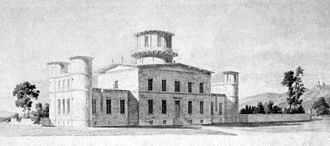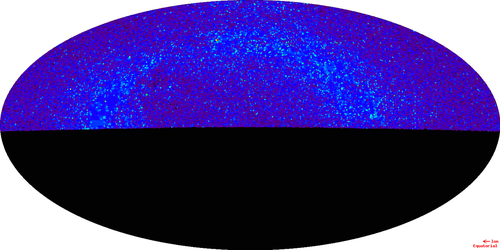Bonn survey

The Bonn survey (BD) is a star catalog (or derived from it an atlas with 36 sheets) based on visual star measurements of the northern sky . The survey was carried out by Friedrich Wilhelm August Argelander at the Bonn observatory of the University of Bonn . It was carried out and published between 1846 and 1863 with the support of Adalbert Krüger and Eduard Schönfeld .
description
A total of around 324,198 stars were measured in the declination range between 89 ° and −2 ° up to size 9.5 (sometimes up to 10). The instrument used for this was a comet finder manufactured by Joseph von Fraunhofer with a 7.7 cm aperture and 65 cm focal length. The right ascension is specified to 0.1 seconds, the declination to 0.1 arc minutes and the visual apparent magnitude to 0.1 mag. The location information refers to the epoch 1855.
Eduard Schönfeld succeeded Argelander as director of the Bonn observatory in 1875. Between 1875 and 1881 he expanded the Bonn survey to include the southern part of all the stars that were barely visible in Bonn. This southern survey contains an additional 133,659 stars.
From 1892 to 1914, the Córdoba observatory (Argentina) began to expand to the southern celestial pole. The Córdoba survey includes around another 578,000 stars.
These "two surveys" form a systematic catalog of over a million stars up to almost a tenth size. They are the last large list created by means of visual observation from the time before the photographic sky mapping.
In the Bonn survey, the individual stars were given consecutive numbers according to the “declination” “consecutive number” scheme. So has z. B. the star Betelgeuse - according to the scheme of Johann Bayer "Alpha Orionis" - the designation BD + 7 ° 1055. That means: the 1055th star at 7 ° north latitude.
The Schröder refractor with a 16 cm aperture and a focal length of around 1.8 meters was used for the Bonn survey. The telescope, built in 1875, is now restored and fully functional at the Hoher List observatory in its own dome and is available for observation.
literature
- Bonn surveys - Argelander and his astronomical legacy for the special exhibition from October 8 to April 5, 2010, Deutsches Museum Bonn, 2010
Web links
- Description at VizieR
- Brief description with further links
- Argelander and the Bonn survey (Michael Geffert, University of Bonn)
- F. Argelander: Bonn survey of the northern sky. First volume. Second edition, A. Marcus and E. Weber's Verlag, Bonn 1903, digitized
- F. Argelander: Bonn survey of the northern sky. Second volume. Second edition, A. Marcus and E. Weber's Verlag, Bonn 1903, digitized
